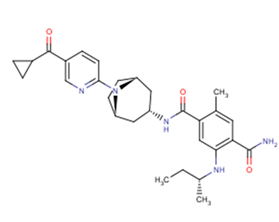
XL888
CAS No. 1149705-71-4
XL888( XL888 | XL-888 | XL 888 )
Catalog No. M17840 CAS No. 1149705-71-4
XL888 is an ATP-competitive inhibitor of Hsp90 ( IC50: 24 nM). Heat shock protein 90 (Hsp90) is a chaperone that maintains the functionality of client proteins involved in cell proliferation, cell cycling, and apoptosis.
Purity : >98% (HPLC)
 COA
COA
 Datasheet
Datasheet
 HNMR
HNMR
 HPLC
HPLC
 MSDS
MSDS
 Handing Instructions
Handing Instructions
| Size | Price / USD | Stock | Quantity |
| 5MG | 120 | In Stock |


|
| 10MG | 195 | In Stock |


|
| 25MG | 357 | In Stock |


|
| 50MG | 537 | In Stock |


|
| 100MG | 781 | In Stock |


|
| 200MG | Get Quote | In Stock |


|
| 500MG | Get Quote | In Stock |


|
| 1G | Get Quote | In Stock |


|
Biological Information
-
Product NameXL888
-
NoteResearch use only, not for human use.
-
Brief DescriptionXL888 is an ATP-competitive inhibitor of Hsp90 ( IC50: 24 nM). Heat shock protein 90 (Hsp90) is a chaperone that maintains the functionality of client proteins involved in cell proliferation, cell cycling, and apoptosis.
-
DescriptionXL888 is an orally bioavailable, ATP-competitive, small-molecule inhibitor of heat shock protein 90 (Hsp90) with potential antineoplastic activity. Hsp90 inhibitor XL888 specifically binds to Hsp90, inhibiting its chaperone function and promoting the proteasomal degradation of oncogenic signaling proteins involved in tumor cell proliferation and survival; inhibition of tumor cell proliferation may result. Hsp90, a chaperone complex protein upregulated in a variety of tumor cell types, regulates the folding and degradation of many oncogenic signaling proteins, including Her-2 and Met.(In Vitro):XL888 is a heat shock protein-90 (HSP90) inhibitor. Treatment with XL888 leads to dose dependent decreases in the growth of all the cell lines with no significant difference in IC50 values observed between the naive and resistance pairs of cell lines (t=0.25, p=0.82). Treatment of all of the vemurafenib resistant cell lines with XL888 (300 nM) induces high levels (>66%) of apoptosis, caspase-3 cleavage and loss of mitochondrial membrane potential (TMRM) in every cell line tested. Treatment of cell lines that are na?ve, intrinsically resistant and with acquired vemurafenib resistance with XL888 (300 nM) leads to robust time-dependent increases in the expression of HSP70 isoform 1 (HSP71).(In Vivo):Treatment of the established M245 tumors with XL888 (125 mg/kg 3× week) leads to a significant slowing of tumor growth (P=0.017) without any effect upon animal weights. Analysis of xenograft specimens by LC-MRM shows a marked increase in intratumoral HSP70 expression following XL888 treatment. It is noted that the XL888 is well tolerated by the mice, with no significant alterations in body weigh observed over the study period. LC-MRM mediated analysis of xenograft samples following 15-days of XL888 treatment shows a robust (8.6-fold) increase in intratumoral HSP70 expression compare to controls.
-
In VitroXL888 is a heat shock protein-90 (HSP90) inhibitor. Treatment with XL888 leads to dose dependent decreases in the growth of all the cell lines with no significant difference in IC50 values observed between the naive and resistance pairs of cell lines (t=0.25, p=0.82). Treatment of all of the vemurafenib resistant cell lines with XL888 (300 nM) induces high levels (>66%) of apoptosis, caspase-3 cleavage and loss of mitochondrial membrane potential (TMRM) in every cell line tested. Treatment of cell lines that are na?ve, intrinsically resistant and with acquired vemurafenib resistance with XL888 (300 nM) leads to robust time-dependent increases in the expression of HSP70 isoform 1 (HSP71).
-
In VivoTreatment of the established M245 tumors with XL888 (125 mg/kg 3× week) leads to a significant slowing of tumor growth (P=0.017) without any effect upon animal weights. Analysis of xenograft specimens by LC-MRM shows a marked increase in intratumoral HSP70 expression following XL888 treatment.It is noted that the XL888 is well tolerated by the mice, with no significant alterations in body weigh observed over the study period. LC-MRM mediated analysis of xenograft samples following 15-days of XL888 treatment shows a robust (8.6-fold) increase in intratumoral HSP70 expression compare to controls.
-
SynonymsXL888 | XL-888 | XL 888
-
PathwayEndocrinology/Hormones
-
Target5-HT Receptor
-
RecptorHSP90
-
Research AreaCancer
-
Indication——
Chemical Information
-
CAS Number1149705-71-4
-
Formula Weight503.6
-
Molecular FormulaC29H37N5O3
-
Purity>98% (HPLC)
-
SolubilityDMSO : ≥ 100 mg/mL; 198.55 mM
-
SMILESCC[C@@H](C)Nc1c(cc(C)c(c1)C(=O)NC1CC2CCC(C1)N2c1ncc(cc1)C(=O)C1CC1)C(=O)N
-
Chemical Name5-((R)-sec-butylamino)-N1-((1R,3s,5S)-8-(5-(cyclopropanecarbonyl)pyridin-2-yl)-8-azabicyclo[3.2.1]octan-3-yl)-2-methylterephthalamide
Shipping & Storage Information
-
Storage(-20℃)
-
ShippingWith Ice Pack
-
Stability≥ 2 years
Reference
1.Taldone T,etal.Discovery and development of heat shock protein 90 inhibitors.Bioorg Med Chem. 2009 Mar 15;17(6):2225-35.
molnova catalog



related products
-
m-Chlorophenylbiguan...
m-Chlorophenylbiguanide hydrochloride is a 5-HT3 receptor agonist.
-
Alisol A 24-acetate
Alisol A 24-acetate has been determined for the quality control of this crude drug.
-
Hesperetin
Hesperetin is a bioflavonoid and, to be more specific, a flavanone.



 Cart
Cart
 sales@molnova.com
sales@molnova.com


